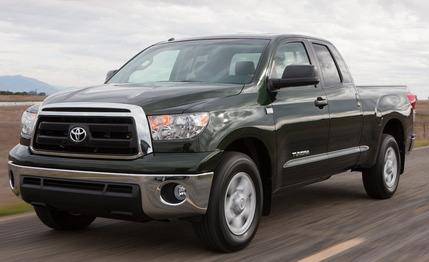
 First Drive Review
First Drive Review
Most cars and trucks sold today offer several choices under the hood: an economical base engine and one or more upgrade powerplants. Not surprisingly, we at Car and Driver tend to view those with the most power as the most desirable. Last year’s spike in gas prices, however, prompted pretty much all power-lovin’ motorists in this country to consider the benefits of engine downsizing.
Holding the Middle Ground
Case in point: Today’s big, porky full-size Toyota Tundra pickup is offered with a choice between a V-6 or one of two V-8s. But only the most powerful of them—a rip-snortin’, stump-pullin’ 381-hp, 401-lb-ft, 5.7-liter V-8 capable of hustling the Tundra’s two-and-a-half tons to 60 mph in six seconds—could get us terribly excited.
With the recession upon us, however, we’re looking with fresh eyes one rung down the ladder. And the introduction of a new mid-grade V-8 for the 2010 Tundra, adding equal helpings of power and efficiency, couldn’t come at a better time. Producing 310 hp and 327 lb-ft of torque, the new 4.6-liter mill replaces last year’s middle-child 4.7-liter V-8, which made 276 hp and 313 lb-ft. Whereas the power gains are appreciable, the engine is a descendant of the 4.6-liter mill that powers the Lexus LS460 and GS460 and can make up to a whopping 380 hp and 367 lb-ft. Although it seems counterintuitive to weaken an engine that is destined for use in, of all things, a full-size pickup, the resultant output figures place it right where it needs to be in the Tundra engine lineup: splitting the difference between the base 236-hp, 4.0-liter V-6 and the aforementioned 5.7-liter powerhouse.
Still No Replacement for Displacement?
Among the numerous efficiency gains made under the hood, as well as the fitment of a six-speed automatic transmission (replacing last year’s five-speed), the mid-grade Tundra engine boasts impressive fuel economy, too—the company estimates that up to 15 city mpg and 20 highway mpg are possible, which places it among the best base V-8s of its competitors and even better than the Tundra V-6, which is EPA rated at 15/19 mpg.
Equipped with the 4.6, the Tundra—at least in the four-wheel-drive Double Cab guise we sampled—won’t light up its tires like it does with the 5.7-liter, yet it is perfectly adequate, allowing one to scoot around town with reasonable gusto and without fear of losing the rear end around every corner. Besides, as we realized—vividly—during a recent stint with a Tundra short cab powered by a supercharged version of the 5.7-liter (with 504 hp and 550 lb-ft of torque), driving overpowered Tundras can become a frustrating battle of wits between the driver and the stability control system—un-fun except in the most controlled circumstances.
Further prompting a more relaxed driving style are the Tundra’s innately low-effort steering and rather numb brakes, neither of which is incapable of performing its respective task and both of which seem rather well suited to the suh-moooooth operation and Lexus-like quietness of the 4.6. Seriously, you could drive through a library in this thing and not get shushed, although you might knock over an encyclopedia rack or two with those massive side mirrors. Buyers seeking a bit more exhaust rumble can find a quick fix with some warranty-sanctioned aftermarket pipes from Toyota Racing Development.
Striking the Right Balance
In all other respects, the refreshed 2010 Tundra offers no surprises. Other than a token grille-slat redesign and new darkened, sparkly plastic interior trim in place of last year’s light-silver bits, the Tundra is pretty much unchanged for 2010. The buttons and the knobs are still cartoonishly huge, and the storage solutions are many and mighty. The SR5 package offers just enough comfort features to be palatable as a personal vehicle, as long as you’re used to being surrounded by hard plastic and sitting on seats upholstered more like the chairs in your dentist’s waiting room than those in your living room.
The 4.6-equipped Tundra is not a bad choice as a dual-purpose truck for average folks or a work truck for everyday use. There might be other trucks from GM, Dodge, and Ford that are more worthy of consideration, but when equipped with the silken 4.6-liter V-8, the Tundra offers better or equal V-8 efficiency and quietness, which are becoming as important as any other purchase considerations.